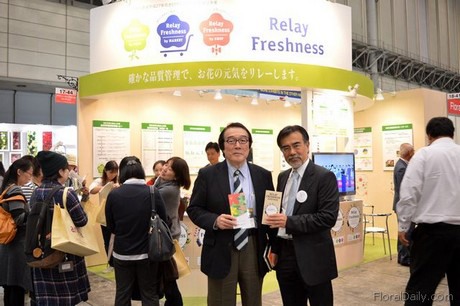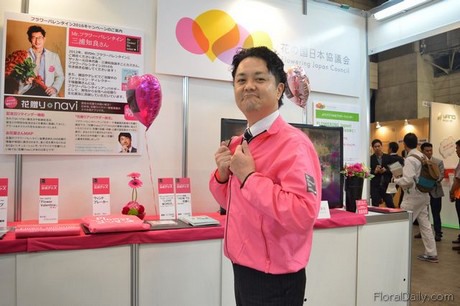
Yoshiyuki Matsushima of MPS Japan and Nobuya Kaishita of Chrysal standing in front of the Relay Freshness booth run by MPS Japan, one of JFMA's initiatives, at the IFEX in Tokyo, Japan.
Decrease flower consumption
Over the years, the retail consumption of cut flowers, garden plants and materials in Japan decreased by 17%; "from 10 billion euros in 1998, to 8.3 billion euros in 2012," and "Especially the consumption of flowers and plants of people under the age of 50 years is low compared to people above this age," explains Kaishita. According to him, the fact that 49 percent of the total Japanese population, and increasingly more younger people, in 2009, do not have a religion is part of the cause for this decrease. "Many homes in Japan have a Buddhist family altar. Usually twice a month, people put Buddhist bouquets mainly consisted of chrysanthemums and carnations in this altar. However, due to the decrease in amount of Buddhists over the last years. This tradition of putting flowers in the altar also declined, which results in a decrease of flower consumption. Therefore, JMFA needs to promote flowers and plants in a different way to the 'younger' age groups," says Kaishita.

Yo Matsumoto of Hibiya-Kadan Floral at the IFEX in Tokyo, Japan. He is part of the Flowering Japan Council, which JFMA members occupy the important roles, and is promoting the use of flowers for Valentine's Day and Halloween in Japan.
Initiatives to promote flower consumption
JFMA is putting a lot of effort into promoting flowers and plants and it expanded to organize ‘Flowering Japan Council’ as an integrated floral organization in Japan. "We need to show people how nice it is to have flowers in their lives," says Kaishita. They are trying to promote flowers in regular festivities, but they are also creating new events for flowers. They are for example promoting ‘Flower Valentine's Day’ and Halloween. "Currently, only women give a gift, namely chocolate, to the men at Valentine's Day. Also Halloween is becoming increasingly popular in Japan and Flowering Japan Council wants to enter these festivity with flowers," says Kaishita.

Relay Freshness.
Besides that, MPS Japan run by JMFA also made a label that indicates the 'Freshness' of flowers and is called ‘Relay Freshness’. According to Kaishita, Japanese people like quality, and research revealed that Japanese consumers want to buy flowers with a longer vase life of more than one week. So, in order to the deliver the expected quality, MPS Japan came up with Relay Freshness. "It checks the post-harvest treatment at the farm, at the market and at the shop with the checklists created by MPS. If they comply with the checklist, they can put a sticker on the sleeve of the plant or flower. So, the green sticker can be used by the farms, the blue by the market and the pink by the shop," explains Kaishita.
Future flower consumption
According to Kaishita, it is a thorough job to promote flowers to the younger generation. Therefore, they are continuously looking for ways to promote flowers. "November 22, for example the pronunciation of this day (11-22) means 'good couple'. We try to make it a day where couples give each other a flower." Besides that, Flowering Japan Council wants to introduce flowers in the casual gift giving market. "In 2010, the gift market of Japan was worth: 141.8 billion euros. This market is divided in casual gifts, personal gifts, seasonal gifts and corporate gifts. The casual gift market, which was 21 percent of the total gift giving market at that time, is the only market that is still increasing. This is a new challenge which Flowering Japan Council should attack," says Kaishita. "If we can only have 10% of this market, it will boost the flower sector. It is also known that the more the home use of flowers is penetrated, the more casually gift giving is spread." Flowering Japan Council is already trying to respond to this trend with Flower Weekend. "This is an ongoing promotion of giving or buying flowers at home for the weekend. Hopefully it will profit from the increasing trend of life with flowers and plants."
For more information
Japan Floral Marketing Association
Chrysal
Nobuya Kaishita
Email: kaishitacj@aol.com
mpsjapan-blog.jugem.jp
